It might look like Muscari, grow like Muscari, and even share a name with Muscari, but Liriope is a plant very much in its own right. This tall, grass-like flowering perennial is one of the most stunning, and easy-to-grow border perennials in any part of Australia.
All it needs is moisture, good soil, and enough sun to keep its shooting spikes of grassy foliage happy. If you’re in any doubt, we’ve got you covered, with an analysis of everything liriope needs to thrive, and how to grow liriope from seed, division, or even mature plants.
And for when you’re done revising, we’ve got a run-through of some of the best liriopes you can grow in Australia too.
More...
Family: | Asparagaceae |
|---|---|
Genus: | Liriope |
Species: | Liriope muscari Liriope spicata |
Common Names: | Lilyturf, Blue Lilyturf, Border Grass, Monkey Grass |
Location: | Outdoor |
Type: | Herbaceous perennial |
Growth: | 40x40cm |
Sun requirements: | Light shade or dappled sun |
Foliage Colour: | Green |
Flower Colour: | Blue |
Flowering: | Summer to early autumn |
Fruit: | None |
Maintenance level: | Low |
Poisonous for pets: | Non-toxic to cats and dogs |
What is Liriope?
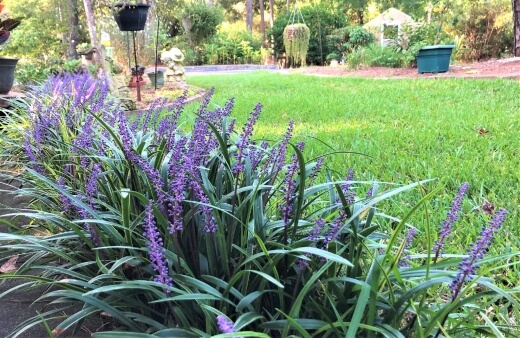
Also known as Lilyturf, Liriope has a beautifully simple habit, growing in clumps from (usually) tuberous roots, which send up dense flower spikes made of tiny globular flowers along a delicately coloured purple stem.
Liriope muscari is the most common species found in garden centres, and is generally a better all-round garden plant thanks to its slow spread, and easy-going nature.
The other key species for gardens is Liriope spicata, which spreads faster, forming swatches of grassy planting quickly in comparison.
Lilyturf’s Natural Habitat
All species in the genus Liriope are native to East Asia with most records in the wild being from China, Japan, Vietnam, and Korea. Despite the relatively mild temperatures compared to ours here in Australia, Liriope copes well with hotter summers thanks to its tuberous or rhizomatous roots, which store water and aid resilience through dry summers.
In their native habitat, they grow in shaded woodlands and forest settings in humid, inland spaces, typically on hill slopes. Despite that, they grow well in most parts of Australia, provided they are protected from extreme sun, or extreme dry spells.
If you are looking for an Australian native bush to grow in your garden then read our guide on how to grow NSW Christmas bush.
Best Liriopes to Grow in Australia
Liriope muscari and Liriope spicata are the only two common species of Liriope, but the range of foliage, flower heights, and hardiness varies greatly with different cultivars.
There are several species synonyms for L. muscari, including ‘exiliflora’, ‘platyphylla' and ‘gigantea’, but none are accepted as species in their own right.
Thankfully, nearly all cultivars of both L. muscari and L. spicata grow well in Australian gardens, provided they receive a little bit of shade, and plenty of moisture.
1. Liriope muscari ‘Gigantea’
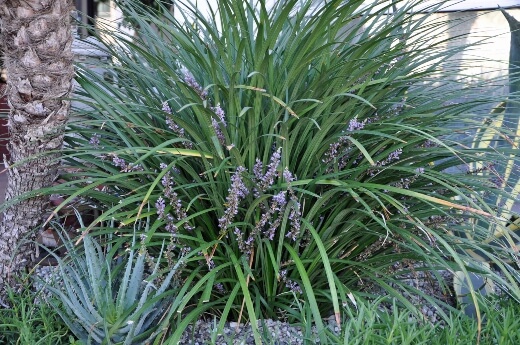
Source: plantmaster.com
As the name suggests, Liriope ‘Gigantea’ is much taller than typical Liriope, growing to around 3ftx3ft per tuber. The tall grassy leaves are tipped with pale yellow, while their flowers are generally hidden within the foliage. To boost flowering, give a low nitrogen feed in spring.
2. Liriope muscari ‘Majestic’ (syn. exiliflora)
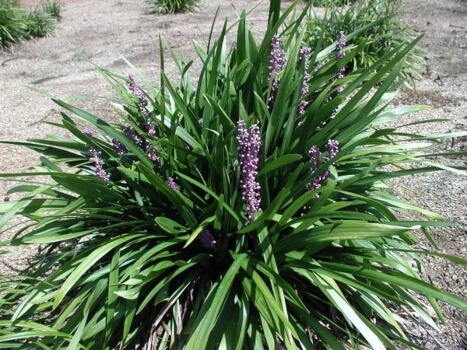
Source: classic-groundcovers.com
Liriope ‘Majestic’ is a gorgeously compact plant, growing to just 1ft tall at the most, with gorgeous deep lilac-coloured flowers. The flowers stick up well beyond the blueish foliage, which tends to fall flatter through summer, and perk back up when the weather is milder.
3. Liriope muscari ‘Big blue’ (syn. ‘platyphylla’)
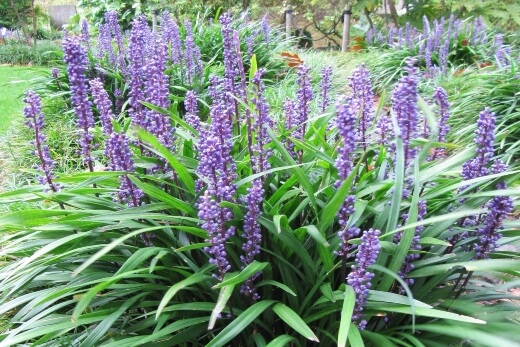
Source: ilexcrenata.eu
Liriope ‘Big Blue’ has much denser flowering habits, with distinct bubbly flower spikes, towering over their grassy bases. Big Blue is a popular garden variety as it spreads fairly slowly, and is very easy to divide and dig out.
Even in late autumn and winter, the flower heads turn to spikes of seed held right the way up the main stem, adding unrivalled winter structure for your beds and borders.
4. Liriope muscari ‘Christmas Tree’
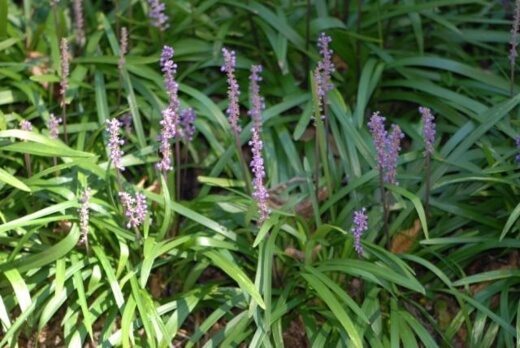
Source: thesitegardener.com
Liriope ‘Christmas Tree’ is just joyful. As flower spikes emerge they flower densely at their base, and narrow out towards the top as they develop through the following weeks.
This leaves you with a beautifully conical spike or pink, bulbous flowers standing tall over the silky green foliage for several weeks before spikes fade into seed heads that last right through winter.
5. Liriope spicata ‘Silver Dragon’

Source: vitaflora.lt
Where Liriope spicata really shine is as ornamental grasses. They might be true grasses, but there is much more variety to be had with foliage shades and patterns through L. spicata cultivars than with most grasses.
‘Silver Dragon’ has breathtakingly beautiful leaf blades, with silver borders and a vivid grey-green midrib that acts as a foil for their purple and pink flower spikes.
Like all L. spicata varieties, ‘Silver Dragon’ does need to be divided quite regularly (every two or three years) to keep it from completely taking over borders.
6. Liriope muscari ‘Evergreen Giant’
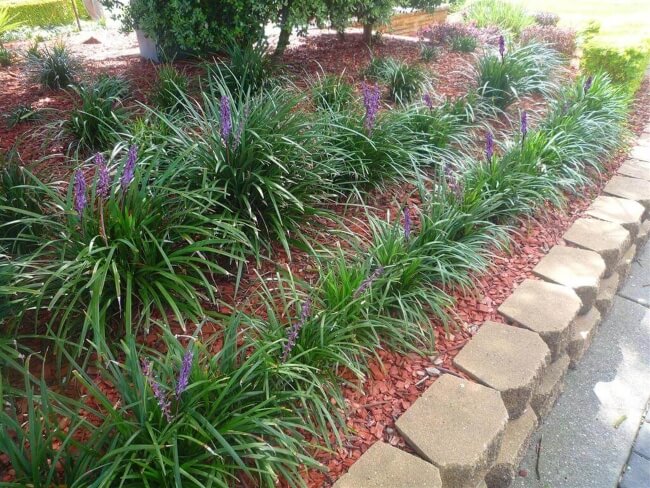
Source: Evergreen Growers
Liriope 'Evergreen Giant' is best left to its own devices in the garden, growing to roughly 1m tall, with a much wider spread. Each plant from an individual tuber will eventually fill out a large section of a border.
The tall flower spikes, with distinct pink-purple colouring, can last from spring through to autumn but generally flower for about four weeks in summer. Like most liriopes, they are commonly mistaken for others in their species (muscari) and others, but they are especially hardy liriopes that will cope with both drought and frost in equal measure.
7. Liriope spicata ‘Franklin Mint’
Growing to about 1.5ft tall, Liriope ‘Franklin Mint’ is one of the best structural plants for any garden. Its foliage isn’t much to write home about, but the pale lavender flower spikes add interest right through summer and autumn, with wide leaves that give clear definition to borders and look gorgeous planted around the base of other shrubs or trees.
How to Grow Liriope in Australia

Liriope grows best in full to partial shade, in a sheltered position away from the wind, and any salty air. As a forest floor plant it grows happily under the canopy of trees, competes well for nutrients against tall shrubs and can help to fill gaps in otherwise difficult shady borders.
Below, we’ll share the best conditions, term-for-term, for any newly planted liriope, but first, you need to know exactly how and when to plant it.
Liriope should be planted in early spring when the air is cooler, and they have access to longer days and more rainfall. This helps them to establish.
As spreading rhizomatous perennials (tuberous perennials in the case of L. muscari) they should be planted in a generous hole, at least twice the width of their pot, to provide enough space for them to spread without becoming compacted.
Best Soil for Lilyturf
Liriope can grow in almost any soil condition, preferring a natural loamy mix, but coping with sand or clay fairly well. Add fresh compost to any planting hole to add moisture retention (particularly if you’re planting under trees or shrubs), and mulch the surface of the soil after watering to lock in moisture for the first couple of weeks.
If you have a soil tester, check your soil pH before planting liriope. They are happy in acid, lightly acid, or neutral soil, but can’t cope with alkaline conditions.
Watering Monkey Grass
If you’re looking for dry shade plants, you’re out of luck. Liriope might love the shade, but it hates having dry roots. Aim for well-drained soil with reasonable water retention so it’s never dry, but never sodden either.
For the first summer, it’s worth watering liriope directly at the root ball once a week. After that, your new lilyturf can cope by itself with natural rainfall.
Light Preference
Liriope can grow in dappled sunlight but prefers shade. Full shade to partial shade is ideal conditions for liriope, so anywhere in the garden that receives less than four hours of direct light per day is perfect.
Temperature
Liriope isn’t particularly picky about temperature. It’s hardy down to around -10C, and provided it’s watered through droughts it can cope with hot summer too. Planting liriope in the shade will help to reduce its direct exposure to heat too.
Ways to Propagate Liriope
There are two ways to propagate liriope, but we much prefer propagating by division once plants have established. Not only is it easier, but it is also cheaper, and quicker too.
However, there is a difference between propagating rhizomatous liriope and tuberous liriope, so we’ll share tips on both below:

Liriope Propagation from seed
Liriope seed is pretty easy to find online and is a common sight in garden centres, but propagation can be tricky due to the hard skins around each seed.
It’s not rocket science, but for new gardeners, knowing how long to soak seeds, water temperatures, and other scarification techniques can be tricky.
So, let’s keep it simple; growing Monkey grass from seed requires seeds to be soaked in room temperature water for around 24 hours.
Soaking softens their shells enough for roots to emerge into their growing medium. Do not scarify them with sandpaper as some forums suggest. This is only useful for woody seeds and nuts.
After soaking liriope seeds, plant them about 1cm deep in sieved compost or seed compost, then water them well and leave them somewhere warm and humid away from direct light. They should germinate in around one month.
Tip: Harvest your own liriope seeds by cutting off full flower spikes when flowers fade, then leaving them to dry in paper bags. After a few weeks, you’ll hear seeds rattling around, having fallen from the stem.
Propagating Liriope Muscari from Division
Liriope muscari is a tuberous perennial, meaning it has fleshy roots that store water. Other common tuberous plants include potatoes, to give you an idea of the sort of root we’re dealing with.
To divide tuberous liriopes, simply dig up a section in autumn or winter, soil and all, then pull it apart by hand. Try to avoid using forks or spades as these can damage the tubers.
Remove about two-thirds of the tubers, and place the rest back in the ground, with some fresh compost to boost growth next spring.
For the rest of the tubers you’ve removed, cut back most of the foliage to take the strain away from the roots, and plant them in pots with fresh compost (2-3 tubers per 20cm is fine to overwinter).
Water them well, then leave them somewhere warm, humid, and shaded over winter. Plant them out in spring when new growth appears.
How to Propagate Liriope Spicata from Division
Dividing Liriope spicata is largely the same as dividing L. muscari, but is somewhat easier. The rhizomatous roots of L. spicata can be divided quite aggressively by simply cutting through them with a clean spade.
Dig up sections to thin out your plants every few years, or to limit their spread, then replant the roots elsewhere, or plant in containers and give them to friends in spring.
How to Care for Liriope
Once it’s established in a shady spot in the garden, liriope copes well without intervention, but it’s still worth dividing clumps and mulching every so often to give your plants a boost. Follow our guide below for ongoing care for mature liriope plants.

Mulching Liriope
Mulch liriope in spring to protect it from drying out over summer. This helps to lock in moisture, and also gives your plants a balanced feed.
Rather than mulching lightly once a year, mulch heavily every two or even three years. 5-10cm of mulch might seem excessive, but these tough plants can easily break through a good layer of compost in spring, and benefit much more from this than a light annual sprinkle.
See our full guide on the types of mulches with details on when and how to use them.
Pruning and Repotting Liriope
Liriope, like most ornamental grasses, doesn’t need cutting back. Their foliage is evergreen and replaces itself each season. However, it’s worth running your hands through the crown of the plant in late spring to remove any old foliage.
Essentially, you just need to brush its hair. This removes dead leaves, and brown materials, and just generally keeps it looking good.
For liriope grown in pots, keep an eye on spacing. Any species of liriope prefers moist soil and likes the ability to spread, so if a plant is starting to fill a pot, remove half of it to allow it space to spread out again.
Dig up the roots, slice them down the middle, and replant it into the same pot. The divided material can be planted in the garden, composted, or given a new container.
Possible Liriope Pests and Diseases

There are virtually no pests in Australia that affect liriope. As a grassy plant, grazing mammals can be a problem, but it’s very unlikely that you’ll ever suffer pest damage to liriope in Australia.
Just because pests aren’t a problem though, doesn’t mean diseases won’t happen. Leaf rot, crown rot, and anthracnose virus are particularly problematic with liriope in warm climates.
They are caused by fungal pathogens and spread by splashing soil, dirty tools, and wind.
Anthracnose
Anthracnose is a yellowing of the leaves and, on liriope, will generally cause any patterned leaves to fade into a single faded tone, with brown leaf margins.
After a while, those brown margins meet up and the whole, moldy mess that’s left will rot off the plant, spreading to other nearby plants. Remove any signs of anthracnose when you see them.
Leaf rot and Crown rot
Leaf rot and Crown rot are generally caused by overly humid conditions, with too little airflow around the plant. This might sound counterintuitive with forest floor plants, but they do still need some airflow.
If you notice brown, mushy, or dying foliage, check the soil moisture with your finger. If it’s damp, just stop watering for a few weeks until it dries out naturally.
If the problem persists, dig up any affected clumps and let the healthy plants grow back into the empty space.
Liriope Frequently Asked Questions
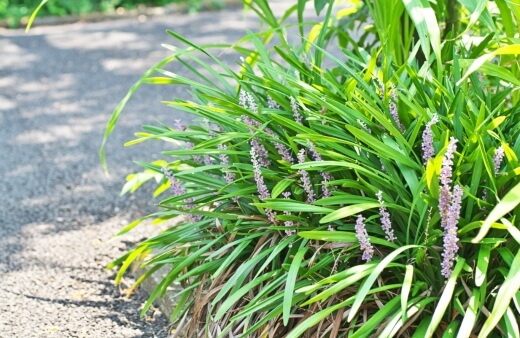
Does liriope need to be cut back?
Liriope doesn’t need to be cut back. An annual hair brush is more than adequate to keep them looking fresh. Their foliage is evergreen and looks best when left to sway through the winter months, before being naturally replaced by fresh green leaves in spring.
What is the best fertiliser for liriope?
Liriope doesn’t really need fertiliser. Mulch them heavily once every few years with good garden compost to maintain a slightly acid to neutral pH and provide balanced nutrition.
If you do feed them, make sure it’s balanced (10-10-10 or 5-5-5 NPK, etc.) so as to keep a good ratio of foliage to flower.
What causes brown tips on liriope?
There are a few reasons that liriope can develop brown tips. One is Anthracnose, a fungal pathogen that causes leaves to develop brown fringes. Another reason could be sunburn, and another could, contradictorily, be over watering, causing the roots to fail.
What can I plant next to liriope?
Liriope are competitive plants. They are slow-spreading, so easy to maintain, but generally take over other plants in their vicinity. Anything planted near liriope should be tough enough to fight for itself, and grow in similar shaded conditions.
Consider Hostas or hardy geraniums for complimentary colours, and clashing foliage. Geraniums in particular look excellent with liriope.
Grow Hardy Liriope in Your Garden
These gorgeous tall alternatives to common muscari (grape hyacinths) are incredible for shaded gardens or a dark spot that you’re unsure what to do with.
Even if you’ve got grape hyacinths growing in the garden, the succession from spring flowering to summer flowering plants is never smoother than from Muscari to Liriope muscari.
Lilyturf is a great choice for a low-maintenance garden that still packs interest all year round, with beautiful evergreen foliage, and striking summer flower spikes.
Growing liriopes might be easy, but just because something’s easy doesn’t make it bad gardening!
Published on September 23, 2022 by Maisie Blevins
Last Updated on February 22, 2024




